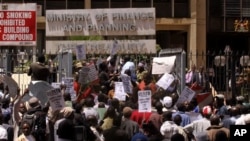Shortages of food and fuel in Kenya are sending the cost of living upwards, threatening political and social crises.
One mango and three bananas at Nairobi's City Market costs 50 shillings, or about $.60. While such prices would certainly attract shoppers in the developed world, many of Kenya's residents live on less than $1 per day, keeping these fruits off the plates of many.
Now, food prices are skyrocketing across east Africa - by some estimates as much as 30 percent since January - putting "luxury" items such as fruits firmly out of the question for a large segment of the country.
And small-scale vendors are also feeling the pain. A vendor at the City Market, Howard Mutua, says the rising costs are cutting into his profits as well as his customers' baskets.
"The normal price I have been taking from the farmers, it has gone up," said Mutua. "By the time I take it from the farmers up to here I am using transportation and the transportation is also high. So I end up increasing my price and that will affect also my customers. They are taking less."
Mutua, like most Kenyans, holds the high taxes imposed by the government on fuel imports responsible for the rising cost of living.
"The best thing I would advise the government to do? They should tackle the fuel problem," Mutua noted. "If they could [work] on that fuel problem, I think everything will be well."
With the government heavily taxing oil imports, the cost of petroleum in Kenya has risen from around $1 per liter to over $1.30 in just the past few months.
But high taxes are not solely to blame for the rising cost of living. Kenyans have been hit from all sides by rising inflation, government tariffs, import mismanagement, Middle East conflict and climate change.
As economic analyst Robert Shaw explains, Kenya's underproduction of staple items has placed it dangerously at the mercy of local and global economic instability.
"In the case of oil it is the volatility that has been taking place in North Africa and some of the Arab countries," noted Shaw. "On the other side of the coin, a number of these countries, including Kenya, are particularly vulnerable to those increases because they are major importers of not just oil but also food. Kenya imports three quarters of its wheat, three quarters of its rice."
Kenya produces an estimated 200,000 tons of corn each year, but consumes nearly twice as much.
And the country may not be able to count on the corn it does produce. Kenya is in the midst of a worsening drought, spurred by the failure of the country's traditional "short rains" season. The "long rains," traditionally expected in March and April, have only just begun and are expected to fall short of historical averages. The price of corn has tripled since last year, forcing the government to remove the 50 percent tax on imports.
In late April, hundreds of Kenyans gathered in front of Parliament to demand action on the rising cost of living.
But so far, government response has been slow. Finance Minister Uhuru Kenyatta announced a 20 percent tax cut on fuel just two weeks ago. The subsidy has come into effect just in time for a fuel shortage across the country. In Nairobi, roads have been gridlocked from morning until night as customers queue in front of petrol stations in the hopes of finding fuel.
And Shaw says the measures undertaken by the government may end up distorting Kenya's markets in the long-run.
"These fuel shortages are not just happening because there happens to be no product," noted Shaw. "According to the government there is plenty of product. The reason is probably because to sell the fuel at the price that has been regulated by the government is really not a viable option."
All of these factors have in turn triggered inflation, which threatens to strengthen the rise in prices. April saw a 12.05 percent inflation rate, the highest in nearly 18 months.
Kenya is not the only country in east Africa feeling the effects of global and local instability. Rising prices in Uganda have triggered protests and demonstrations over rising costs. Over the past month, the protests have been crushed with the full force of Uganda's military and police. But scenes of opposition leaders being arrested and beaten have triggered international condemnation and pushed the country to the brink of a political crisis.
Kenya is hoping to avoid the same fate, but may not be able to stem the rising tide of discontent. Workers are becoming increasingly fed up and organized labor is beginning to demand higher wages to cope.
On Labor Day, the leader of Kenya's Central Organization of Trade Unions, Francis Atwoli, threatened strikes and protests if demands for a 60 percent increase in the minimum wage were not met.
But Shaw says raising wages could make matters worse.
"You can understand the demands but, quite honestly, in the bigger picture it's very difficult because you will actually create an even greater spike in inflation. In the end, it's likely that there won't be any major winners," added Shaw.
As prices continue to rise, Kenyans are watching and waiting to see if the government can head off what some are calling a looming crisis.
Cost of Living Rising in Kenya












